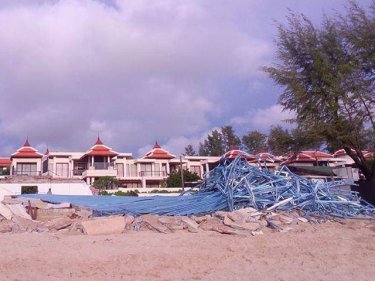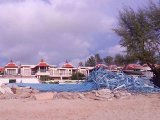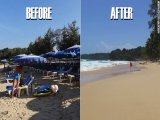PHUKET: With an amazing 1250 true beachfront accommodations establishments, Thailand has won the Global Beachfront Awards, beating the US and Mexico into second and third places, followed by Spain and Greece, with the Philippines, Italy and Turkey tagging behind with significantly fewer qualified hotels and resorts.
''True beachfront'' means only those hotels and accommodations directly on the beach or oceanfront, with no road or traffic between the rooms and the water.
This website has now more than 12,000 qualified hotels in its database (though some are not yet mapped). Thailand's win over so many heavyweights of global tourism might surprise some people.
Thailand is rising fast in global tourism
This No 1 position in the Global Beachfront Awards comes as Thailand reached the Top 10 tourism destinations worldwide for the first time, coming in at No 10 in 2013 with 27.4 million international visitors.
In the five years between 2009 and 2013 Thailand recorded the world's highest rate of tourism growth by a wide margin. And the largest number of those visitors, by far, were headed for Thai beaches.
Bangkok is a hugely popular stopover that now attracts many millions of visitors annually, but the number of those visitors continuing north to Chiang Mai and other cultural destinations is just a small fraction of those heading south to Thailand's now-famous beaches.
Lucky geography, lucky weather
Geography has blessed Thailand with coastlines facing two of the world's great oceans, the Pacific and the Indian. Both coasts have hundreds of islands, countless beaches and beautiful marine environments.
Few countries in the world are so blessed with such abundance in beach beauty and diversity.
Both the Pacific and Indian oceans brew up many violent tropical typhoons each year, then hurl them at Asian coastlines with deadly destruction. The Philippines, China and Vietnam take the brunt of the Pacific violence, while Bangladesh is often smashed by Indian Ocean storms.
Yet Thailand, right in the middle and forming the barrier that divides these two great weather systems, is rarely touched.
Lucky timing - as old beaches grow stale, trend moves to Southeast Asia
The Mediterranean, for long the favorite playground of wealthy Europeans, has huge pollution problems, and its beaches are often over-crowded. The Caribbean also remains popular, but for many of its long-time guests, the levels of violence are a put-off and the limited local culture and few attractions beyond the beach make this less welcoming and less 'exotic' than Asia.
Beach-lovers in both Europe and North America are now seeking new, more pristine sands in an era when long distance travel is faster and cheaper than ever.
The longer travel times to the new beach destinations in Southeast Asia have are now affordable for millions of beach-lovers who are willing to spend long hours on a plane in order to get to the new, refreshing beach destinations of tropical Asia.
Spain, where beaches are also the major attraction, gets over 60 million tourists a year - more than double Thailand's best. But the rise in Spanish tourism over the past five years totalled just 16 percent, tiny beside Thailand's whopping 88 percent increase.
Turkey and Greece, also traditional seaside escapes for beach-loving Europeans, had similar, small gains, showing that the appeal of the old beach destinations is waning.
In the whole of the Caribbean tourism rose by only 1.5 percent per year since 2005, while the figure for Southeast Asia over the same period was 8.5 percent annually, more than five times higher.
The trend is obvious: the beaches of Southeast Asia, and Thailand in particular, hold the future.
Thailand offers natural beach environments & great variety
A more pristine, natural environment ranks high among the desires of visitors from developed countries, and even among the new wave of visitors from highly urbanised China. Thailand's beach environments are - relatively speaking - in reasonably good condition.
We say this tenuously, for environmental degradation and over-development are perhaps the greatest current threats to Thai beaches, and these dangers continue to rampage across its islands and beaches largely unchecked.
While Spanish and Mexican beach hotels are often huge, with many hundreds of rooms each, they run short on variety. And their beaches lack the 'exotic' appeal of their tropical Asian counterparts.
Diversity in both beaches and choices of accommodations is Thailand's forte. The widely divergent geography from the Andaman coast to the Gulf of Thailand gives the country an amazing choice of islands, big and small, while the beaches may be remote and empty or party-packed with people and fun. There's such amazing variety in Thailand's beach choices.
The country's thousand plus beachfront accommodations span every price and quality range, from $5 backpacker huts to super-luxurious, international five-star resorts. The new wave of creatively-designed, boutique beach resorts is helping push Thai accommodations to the forefront, while still offering something for every taste and budget.
Thai characteristics; food, culture, service
While Southeast Asia recorded the world's fastest growth in tourism between 2009 and 2013, Thailand was the biggest winner, taking some 40 percent of all visitors to this region. Thai Buddhist culture is to be credited for much of this success in outshining its neighbors.
Thai cuisine is so famous it needs no introduction. Thais display both a gentle grace and the confidence to welcome strangers into their country and homes. And Thai service is renown for coming from the heart.
Together, these elements create a more interesting, more ''exotic'' and more inviting country than others in tropical Asia, despite that many have equally beautiful beaches.
Can Thailand sustain its star role in beach tourism?
Thailand's beach tourism industry faces so many dangers from environmental degradation and over-development that its chances of retaining the top spot in beach tourism well into the future is in doubt. It is noteworthy that the first major clean up of encroachment on Phuket's beaches was initiated by the military government in July 2014. For now, Thailand's beach environments remain more natural than most, while the future remains uncertain.
To highlight the dangers to Thai beaches and related environments we have created a Challenges & Dangers to Thai Beaches;
http://thebeachfrontclub.com/guide/what-dangers-to-thailands-burgeoning-beach-tourism-industry
*The Bangkok-based website defines true beachfront hotels as those directly on the beach or oceanfront with no road or traffic between the rooms and the water.
















I bit wonder where Movenpick Bang Tao (exPalm Beach Club) guests having a breakfast and where a kitchen is located, as all that one was in the only restaraunt is Palm Tree restaraunt - perhaps serve by the pool and cook like egg master station there as well.
Surely they had to be making more thourough analysis when they acquired property and the business.
Posted by Sue on August 16, 2014 17:45